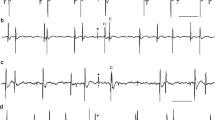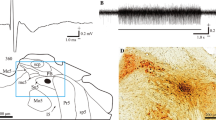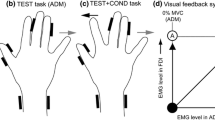Abstract
The influence of muscle fatigue on the jaw-closing muscle spindle activity has been investigated by analyzing: (1) the field potentials evoked in the trigeminal motor nucleus (Vmot) by trigeminal mesencephalic nucleus (Vmes) stimulation, (2) the orthodromic and antidromic responses evoked in the Vmes by stimulation of the peripheral and central axons of the muscle proprioceptive afferents, and (3) the extracellular unitary discharge of masseter muscle spindles recorded in the Vmes. The masseter muscle was fatigued by prolonged tetanic masseter nerve electrical stimulation. Pre- and postsynaptic components of the potentials evoked in the Vmot showed a significant reduction in amplitude following muscle fatigue. Orthodromic and antidromic potentials recorded in the Vmes also showed a similar amplitude decrease. Furthermore, muscle fatigue caused a decrease of the discharge frequency of masseter muscle spindle afferents in most of the examined units. The inhibition of the potential amplitude and discharge frequency was strictly correlated with the extent of muscle fatigue and was mediated by the group III and IV afferent muscle fibers activated by fatigue. In fact, the inhibitory effect was abolished by capsaicin injection in the masseter muscle that provokes selective degeneration of small afferent muscle fibers containing neurokinins. We concluded that fatigue signals originating from the muscle and traveling through capsaicin-sensitive fibers are able to diminish the proprioceptive input by a central presynaptic influence. In the second part of the study, we examined the central projection of the masseter small afferents sensitive to capsaicin at the electron-microscopic level. Fiber degeneration was induced by injecting capsaicin into the masseter muscle. Degenerating terminals were found on the soma and stem process in Vmes and on the dendritic tree of neurons in Vmot. This suggests that small muscle afferents may influence the muscle spindle activity through direct synapses on somata in Vmes and on dendrites of neurons in Vmot.










Similar content being viewed by others
References
Bae YC, Nakagava S, Yasuda K, Yabuta NH, Yoshida A, Pil PK, Moritani M, Chen K, Nagase Y, Takemura M, Shigenaga Y (1996) Electron microscopic observation of synaptic connection of jaw-muscle spindle and periodontal afferent terminals in the trigeminal motor and supratrigeminal nuclei in the cat. J Comp Neurol 374:421–435
Baker R, Llinas R (1971) Electronic coupling between neurones in the rat mesencephalic nucleus. J Physiol (Lond) 212:45–63
Bigland-Ritchie B, Johansson RS, Lippold OCJ, Smith S, Woods JJ (1983) Changes in motoneurone firing rates during sustained maximal voluntary contractions. J Physiol (Lond) 340:335–346
Bigland-Ritchie B, Dawson N, Johansson RS, Lippold OCJ (1986) Reflex origin for the slowing of motoneurone firing rates in fatigue of human voluntary contractions. J Physiol (Lond) 379:451–459
Bongiovanni IG, Hagbarth KE (1990) Tonic vibration reflexes elicited during fatigue from maximal voluntary contractions in man. J Physiol (Lond) 423:1–14
Cairns BE, Sessle BJ, Hu JW (1998) Evidence that excitatory amino acid receptors within the temporomandibular joint region are involved in the reflex activation of the jaw muscles. J Neurosci 18:8056–8064
Chase MH, Nakamura Y (1968) Inhibition of the masseteric reflex by vagal afferents. Experientia 24:918–919
Cody FWJ, Harrison LM, Taylor A, Weghofer J (1974) Distribution of tooth receptor afferents in the mesencephalic nucleus of the fifth cranial nerve. J Physiol 239:49P–50P
Della Torre G, Lucchi ML, Brunetti O, Pettorossi VE, Clavenzani P, Bortolami R (1996) Central projections and entries of capsaicin-sensitive muscle afferents. Brain Res 713:223–231
Della Torre G, Brunetti O, Pettorossi VE (2002) Capsaicin-sensitive muscle afferents modulate the monosynaptic reflex in response to muscle ischemia and fatigue in the rat. Arch Ital Biol 140:51–65
Dessem D, Taylor A (1989) Morphology of jaw-muscle spindle afferents in the rat. J Comp Neurol 282:389–403
Duggan AW, Hope PJ, Lang CW, Williams CA (1991) Sustained isometric contraction of skeletal muscle results in release of immunoreactive neurokinins in the spinal cord of the anaesthetized cat. Neurosci Lett 122:191–194
Gandevia SC (2001) Spinal and supraspinal factors in human muscle fatigue. Physiol Rev 81(4)
Gottlieb S, Taylor A, Bosley MA (1984) The distribution of afferent neurones in the mesencephalic nucleus of the fifth nerve in the cat. J Comp Neurol 228:273–283
Grassi C, Deriu F, Passatore M (1993) Effect of sympathetic nervous system activation on the tonic vibration reflex in rabbit jaw closing muscles. J Physiol (Lond) 469:601–613
Harper HH, Lawson SN (1985) Conduction velocity is related to morphological cell type in rat dorsal root ganglion neurons. J Physiol (Lond) 359:31–46
Hinrichsen CFL, Larramendi LMH (1968) Synapses and cluster formation of the mouse mesencephalic fifth nucleus. Brain Res 7:296–299
Holzer P (1991) Capsaicin: cellular targets, mechanisms of action, and selectivity for thin sensory neurons. Pharmacol Rev 43:143–201
Honma S, Moritani M, Zang L-F, Lu L-Q, Yoshida A, Appenteng K, Shigenaga Y (2001) Quantitative ultrastructure of synapses on functionally identified primary afferent neurons in the cat trigeminal mesencephalic nucleus. Exp Brain Res 137:150–162
Jancso G, Lawson SN (1990) Transganglionic degeneration of capsaicin-sensitive C-fiber primary afferent terminals. Neuroscience 39:501–511
Jancso G, Kiraly E, Joo F, Such G, Nagy A (1985) Selective degeneration by capsaicin of a subpopulation of primary sensory neurons in the adult rat. Neurosci Lett 59:209–214
Kenins P (1982) Responses of single nerve fibres to capsaicin applied to the skin. Neurosci Lett 29:83–88
Kishimoto H, Bae YC, Yoshida A, Moritani M, Takemura M, Nagakawa S, Nagase Y, Wada T, Sessle BJ, Shigenaga Y (1998) Central distribution of synaptic contacts of primary and secondary jaw muscle spindle afferents in trigeminal motor nucleus of the cat. J Comp Neurol 391:50–63
Kolta A, Lund JP, Rossignol S (1990) Modulation of activity of spindle afferents recorded in trigeminal mesencephalic nucleus of rabbit during active mastication. J Neurophysiol 64:1067–1076
Kolta A, Lund JP, Westberg KG, Clavelou P (1995) Do muscle spindle afferents act like interneurons during mastication? Trends Neurosci 18:441
Lazarov NE (2000) The mesencephalic trigeminal nucleus in the cat. Adv Anat Embryol Cell Biol 153:1–103
Lazarov NE (2002) Comparative analysis of the chemical neuroanatomy of the mammalian trigeminal ganglion and mesencephalic trigeminal nucleus. Progr Neurobiol 66:19–59
Liem RSB, Copray JCVM, Van Willingen JD (1991) Ultrastructure of the rat mesencephalic trigeminal nucleus. Acta Anat 140:112–119
Liem RSB, Copray JCVM, Van Willingen JD (1992) Distribution of synaptic boutons in the mesencephalic trigeminal nucleus of the rat: a quantitative electron-microscopical study. Acta Anat 143:74–78
Linden RWA (1978) Properties of intraoral mechanoreceptors represented in the mesencephalic nucleus of the fifth nerve in the cat. J Physiol 279:395–408
Lou J, Li P (1991) Monosynaptic connections between neurons of trigeminal mesencephalic nucleus and jaw-closing motoneurons in the rat: an intracellular horseradish peroxidase labelling study. Brain Res 559:267–275
Lou PF, Wang BR, Peng ZZ, Li JS (1991) Morphological characteristics and terminating patterns of masseteric neurons of the mesencephalic trigeminal nucleus in the rat: an intracellular horseradish peroxidase labeling study. J Comp Neurol 303:286–299
Lucchi ML, Bortolami R, Callegari E (1972) Ultrastructural features of mesencephalic trigeminal nucleus cells in cat, rabbit and pig. J Submicrosc Cytol 4:7–18
Lund JP, Kolta A, Westberg KG, Scott G (1998) Brainstem mechanisms underlying feeding behaviors. Curr Opin Neurobiol 8:718–724
Lynn B (1990) Capsaicin: action on nociceptive C fibers and therapeutic potential. Pain 41:61–69
Macefield VG, Hagbarth KE, Gorman R, Gandevia SC, Burke D (1991) Decline in spindle support to α-motoneurones during sustained voluntary contractions. J Physiol (Lond) 440:497–512
Manni E, Bortolami R, Pettorossi VE, Callegari E, Lucchi ML (1977) Reflex and reticular modulation of first-order proprioceptive neurons of the mesencephalic trigeminal nucleus. Arch Ital Biol 115:20–37
Manni E, Lucchi ML, Filippi GM, Bortolami R (1982) Area postrema and the mesencephalic trigeminal nucleus. Exp Neurol 77:39–55
Matsuo R, Ikehara A, Nokubi T, Moritomo T (1995) Inhibitory effect of sympathetic stimulation on activities of masseter muscle spindles and the jaw jerk reflex in rats. J Physiol (Lond) 483:239–250
Miyazaki R, Lushei ES (1987) Responses of neurons in nucleus supratrigeminalis to sinusoidal jaw movements in the cat. Exp Neurol 96:145–157
Passatore M, Bortolami R, Lucchi ML, Filippi GM, Manni E (1979) Cortifugal influences of the cerebral masticatory area on the mesencephalic trigeminal nucleus of the rabbit. Arch Ital Biol 117:340–360
Passatore M, Lucchi ML, Filippi GM, Manni E, Bortolami R (1983) Localization of neurons innervating masticatory muscle spindle and periodontal receptors in the mesencephalic trigeminal nucleus and their reflex actions. Arch Ital Biol 121:117–130
Pettorossi VE (1983) Modulation of the masseteric reflex by gastric vagal afferents. Arch Ital Biol 121:67–79
Pettorossi VE, Bortolami R, Della Torre G, Brunetti O (1994) Effect of capsaicin in the motor nerve. Exp Neurol 128:284–289
Pettorossi VE, Della Torre G, Bortolami R, Brunetti O (1999) The role of capsaicin-sensitive muscle afferents in fatigue-induced modulation of the monosynaptic reflex in the rat. J Physiol (Lond) 515:599–607
Pini A (1983) Effects of capsaicin on conduction in a cutaneous nerve of the rat. J Physiol 338:60p–61p
Ro JY, Capra NF (2001) Modulation of jaw muscle spindle afferent activity following intramuscular injection with hypertonic saline. Pain 92:117–127
Ryuji M, Akio I, Takashi N, Toshifumi M (1995) Inhibitory effect of sympathetic stimulation on activities of masseter muscle spindles and the jaw jerk reflex in rats. J Physiol (Lond) 483:239–250
Shigenaga Y, Sera M, Nishimori T, Suemune S, Nishimura M, Yoshida A, Tsuru K (1988) The central projection of masticatory afferent fibres to the trigeminal sensory nuclear complex and upper cervical spinal cord. J Comp Neurol 268:489–507
Westberg KG, Kolta A, Clavelou P, Sandstrom G, Lund JP (2000) Evidence for functional compartmentalization of trigeminal muscle spindle afferents during fictive mastication in the rabbit. Eur J Neurosci 12:1145–1154
Woods JJ, Furbush F, Bigland-Ritchie B (1987) Evidence for a fatigue-induced reflex inhibition of motoneurone firing rates. J Neurophysiol 58:125–137
Yang HW, Appenteng K, Batten TFC (1997a) Ultrastructural sub-types of glutamate-immunoreactive terminals on the rat trigeminal motoneurones and their relationships with GABA-immunoreactive terminals. Exp Brain Res 114:99–116
Yang HW, Min MY, Appenteng K, Batten TFC (1997b) Glycine-immunoreactive terminals in the rat trigeminal motor nucleus: light- and electron-microscopic analysis of their relationships with GABA-immunoreactive terminals. Brain Res 749:301–319
Yu XM, Sessle BJ, Haas DA, Izzo A, Vernon H, Hu JW (1996) Involvement of NMDA receptor mechanisms in jaw electromyographic activity and plasma extravasation induced by inflammatory irritant application to temporomandibular joint region of rats. Pain 68:169–178
Acknowledgements
This research was supported by a grant from the CNR and the Italian Ministry of University and Scientific Research. We wish to thank H.A. Giles MA for her advice on the English language, and M. Roscini for technical assistance.
Author information
Authors and Affiliations
Corresponding author
Rights and permissions
About this article
Cite this article
Brunetti, O., Della Torre, G., Lucchi, M.L. et al. Inhibition of muscle spindle afferent activity during masseter muscle fatigue in the rat. Exp Brain Res 152, 251–262 (2003). https://doi.org/10.1007/s00221-003-1544-z
Received:
Accepted:
Published:
Issue Date:
DOI: https://doi.org/10.1007/s00221-003-1544-z




